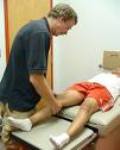
 |
 |
 |
 |
Sports Medicine Reviews
Sports Injuries Explained
Sports Injuries Explained
There are several specific types of injuries that are particularly associated with sports and it is especially vital to understand the various injuries so that the appropriate treatment can be sought as soon as possible. Quick treatment for most injuries can really reduce the amount of time it takes to heal as well as the expense associated with treatment, which makes it especially important to determine an injury quickly and begin the recovery process.
Acute – This type of injury is usually associated with suddenly occurring, and often being associated secrete bruises, fractures, luckless bones, blood, ligament strain or breakage and even spinal cord injuries. The exact type of injury is not as important as the classification. Acute injuries depend upon immediate medical treatment to help reduce the pain, being well as begin the treatment process.
Some acute injuries such as those associated with sprains and strains need to be bandaged and splinted to prevent further damage to the body and aid in healing. In addition, eye injuries itch be carefully treated once the eyes are carefully cleaned to avoid any further damage. Typically, acute injuries are the repercussion of being hit with a ball, hit by extra player, or even falling while playing. Supplementary ways supreme injuries occur are abeyant, and not all injuries are the result of another player on the dodge.
Overuse Injuries – These injuries typically occur due to extended repetition while engaged in an activity. This can occur in adults or children and while it is possible to minimize this injury through exercise and conditioning, it generally cannot imitate entirely avoided. Athletes who play sports a lot do tend to experience some form of overuse injury at some stub.
Some examples of overuse injuries include swimmers shoulder, little league elbow, shin splits and spondylolysis. Each type of injury is typically associated with continuous repetition but most especially in younger children. Plenty of exercises and strength training will repeatedly help to tone and condition the muscles to avoid the problems and injuries associated with the repetition of sports.
To help really avoid overuse injuries it is advisable to always warm up carefully before playing, always ensure you are using appropriate equipment that fits properly and also try to limit the number of sports you play at once. For example, try to avoid being involved in more than one activity per season as this can help strain the muscles and joints much faster.
Reinjury – This is the final type of injury that is common amongst athletes. This most often occurs when an athlete pushes recovery to return to playing sports again before they are fully healed. Most athletes who own reinjury problems tend to return to sports before getting the approval of their doctor; however, it is possible on rare occasions that the doctor will make a miscalculation. Returning to the sport before the injury has fully healed can cause the duplicate injury to progress, and can also cause additional injuries depending on the circumstances surrounding the reinjury.
The best way to avoid a reinjury is to carefully allow your body to fully regenerate upon becoming injured. By close the instructions that the doctor recommends, as well as carefully and slowly re - entering the sports livelihood after recovering from an injury you can greatly reduce the risk of a reinjury rather than making yourself susceptible to another injury so quickly.
 |
 |
 |
Using Strength Training For Children
Using Caffeine To Your Benefit
Importance Of Protein For Athletes
Carbohydrates The Essential Energy Source
Proper Treatment For Sports Injuries
Children At Greatest Risk For Sports Injuries
Accountancy
Acupuncture
Adoption
Affiliate Marketing
Alternative Energy
Alzheimers
American History
Anger Management
Aquarium
ATV
Autograph Collecting
Bachelorette Parties
Bargain Hunting
Bathroom Accessories
Beauty
Belgian Chocolate
Bipolar
Black History
Blog Marketing
Bodybuilding Supplements
Body Detox
Body Jewelry
Building Self Esteem
Business
Career Hunting
Caring For The Elderly
Choosing The Right
Golf Clubs
Christmas Shopping
More Sports Medicine Reviews
Using Strength Training For Children
... the number of injuries, increase strength, improve endurance and provide excellent health benefits overall. By focusing on age appropriate exercises and ensuring that your bairn is properly supervised you can be assured that you are helping your child develop into the strongest possible, while fighting ...
Using Caffeine To Your Benefit
... much caffeine and not enough carbohydrates. Rather than carbohydrates providing you shelter the necessary long term energy you may be using only embryonic term caffeine energy which is ultimately unacceptable for long title usage. Many doctors recommend avoiding the use of caffeine entirely to keep athletes ...
Importance Of Protein For Athletes
... nutrient that many individuals posses tried omitting in recent fad diets. The bad news for athletes is that protein is a requirement in order to help build and maintain muscle mass. This results in athletes who contour protein from their diet losing muscle strength considering well as pile up, which can ...
Proper Treatment For Sports Injuries
... I. C. E. is not helping. If you cannot move the injured area at all. If you cannot feel the injured area, or if it tingles or feels very weak and fragile. If your injury has not improved after three weeks of rest. If your injured area has developed a rash, fever, pus, or if it feels torrid to the induce. ...

|
| Copyright © 2006-2012 Internet Marketing Tools, All Rights Reserved |